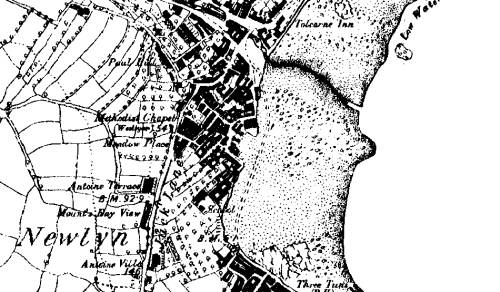
Newlyn Walks No. 2
Street-an-Nowan

THE
Newlyn that we know today was originally divided into separate small
communities, which with the passage of time, and the building of bridges and
roads merged into one. In the 1930's Charles Henderson, the noted Cornish
historian, carried out some research into Cornish place and field names. In
his research he came up with the following names for what has now become
Newlyn:
Lulyn 1289, 1328, 1368;
Lulyn juxta Talcarn 1321;
Bethkele juxta Lewelyn 1388;
Jacford juxta Lulyu 1289;
Lulyn and Jaghford 1424;
Streetonowan (undated).
These then were the separate areas which today make up the whole of Newlyn. In days gone by and even as late of the last century the people living in the different areas tended to stay in their own communities.
STREET-AN-NOWAN, (Stret an Ogten), Date Unknown.
The
date of origin of this is unknown. However, it means "Street of the
Oxen". The area extends from North Corner to the Tolcarne river. Before the
The Bridge's & Bridge House
We cross the river by the second of the three bridges. looking to the right we can see the clapper bridge which it is thought dates from medieval times and beyond it the bridge constructed in 1910 when the new road was built. The bridge we are standing on is still referred to as the new bridge although its construction is believed to have been

On our right after crossing the bridge is Bridge House. Built in 1895 following a fire which destroyed the original building which belonged to the
Fish sellers
JAGHFORD, (Jay forth, jog way). 1289, 1424.
This became known as "Jack Lane"
which took over from Old Paul Hill as the route to Paul from Tolcarne and
Street-an-nowan. The name Jack Lane has in turn given way to Paul Hill although
officially named Chywoone Hill. However, Jack Lane seems to refer to Jaghford, and could indicate
the start of the long jog up the hill to Paul.
To market to market to buy a fat pig
Home again home again jigity jig.
To market to market to buy a fat hog,
Home again home again jigity jog.
TALCARN, (Tat Cain), brow of the carn. 1321.
This is the present Tolcarne district, and takes its name from the rock pile that is known as the Devil’s Rock. It is on the other side of the river from Street-an-nowan.
BUCCAS PASS:
When the new road from Penzance was built and the Tolcarne River bridged on the new site the authorities decided to continue the road on through to the village of Sheffield and beyond. In order to do this a new piece of road was cut to reach Jack Lane as it turned up towards Paul. This meant by-passing the old Newlyn bridge and the cross roads at the lower part of Jack Lane. When it was also announced that a special rate was to be set to pay for the road it was ironically pointed out that the NEWLYN BUCCAS, the nickname given to people from Newlyn, would be paying for people from Penzance and other places to by-pass their town with the loss this would mean in trade. People in Penzance continued to call New Paul Hill Buccas Pass for some years.
FOUNDRY LANE:
This is the site in Street-an-Nowan, between the Fradgan and Jack Lane, of the old engineering works that closed down in 1889, about the same time as the Trereife Smelting Works at Stable Hobba in Newlyn Coombe. They were engaged in making castings for boat and fireplaces such as the Cornish Slab.
FRADGAN:
For’oyan, ox
road. [Another possibility is far’
ascen, ass road, with s become
j]. This is part of Street-an-nowan,
where we naturally look for some mention of oxen. A farm did exist here,
close to Gwavas Quay, and was still standing in 1900 before being turned into
a fish store adjacent to Mary Kelynack’s cottage. In the nineteen
hundreds the fields
behind were known as “ Farmer’s Meadows” and. “the Orchard.” all
being links with the past and Newlyn school of artists studios.
CHAMPION’S SLIP:
On
the old road running from Gwavas Quay to Newlyn Town, this slip at the rear of the
old canning factory, was named after a local head master of the
Wesleyan School situated at the top.